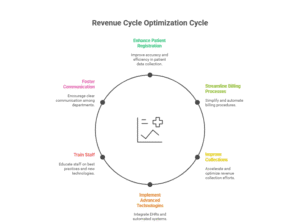On-Demand Outsourcing BPO Services for Healthcare Providers With 24/7 Coverage!
Save up to 70% on staffing costs!
Browse Specialty Staffing ServicesOptimizing the Healthcare Revenue Cycle Management Process: A Strategic Guide

In the complex world of healthcare administration, revenue cycle management (RCM) plays a critical role in ensuring financial sustainability. It encompasses the entire financial process of patient care, from appointment scheduling to final payment collection. As the healthcare industry continues to shift toward value-based care and digital transformation, optimizing the RCM process has become essential for reducing inefficiencies, increasing revenue, and improving the patient experience.
Understanding the Revenue Cycle in Healthcare
The healthcare revenue cycle includes all administrative and clinical functions that contribute to the capture, management, and collection of patient service revenue. It typically involves the following steps:
-
Pre-Registration and Eligibility Verification
-
Patient Registration
-
Charge Capture
-
Coding and Claims Submission
-
Payment Posting
-
Denial Management
-
Accounts Receivable Follow-Up
-
Patient Collections
Each of these steps presents opportunities for optimization and potential risk for revenue leakage if mishandled.
Key Challenges in RCM
-
Claim Denials and Delays: Inaccurate coding, missing documentation, or eligibility issues can lead to denied or delayed claims.
-
Fragmented Systems: Disparate software solutions or lack of integration hampers workflow efficiency.
-
Manual Processes: Paper-based workflows or non-automated systems contribute to human error and inefficiencies.
-
Poor Patient Communication: A lack of price transparency or confusing billing statements can delay or deter payment.
Strategies for Revenue Cycle Optimization

1. Implement Robust Front-End Processes
-
Accurate Eligibility Verification: Automate insurance checks to confirm coverage before appointments.
-
Pre-authorization: Ensure prior authorizations are secured where necessary to avoid denials.
-
Patient Education: Provide upfront cost estimates and clear communication about payment expectations.
2. Enhance Clinical Documentation and Coding
-
CDI Programs: Implement Clinical Documentation Improvement programs to ensure documentation supports accurate coding.
-
Coder Training: Ongoing education and audits for coding staff to remain current with ICD-10 and CPT changes.
-
Technology Integration: Leverage natural language processing (NLP) and AI tools for real-time documentation support.
3. Automate Claims Management
-
Claims Scrubbing: Use automated tools to check claims for errors before submission.
-
Integrated Clearinghouses: Reduce the time between submission and payer response.
-
Track Claim Status: Employ dashboards and alerts to monitor claim life cycles.
4. Strengthen Denial Management and Appeals
-
Root Cause Analysis: Identify trends and recurring errors that lead to denials.
-
Workflow Automation: Prioritize and auto-route denials to the appropriate team members.
-
Appeals Process: Standardize and document best practices for timely appeals.
5. Accelerate Patient Payments
-
Digital Payment Platforms: Offer online portals, mobile payment, and installment plans.
-
Transparent Billing: Simplify billing statements and ensure consistency in communication.
-
Early Engagement: Use text, email, or phone reminders for upcoming bills and due dates.
6. Data-Driven Performance Monitoring
-
KPI Tracking: Monitor metrics like Days in Accounts Receivable (A/R), Clean Claim Rate, and Denial Rate.
-
Benchmarking: Compare performance against industry standards to identify improvement areas.
-
Revenue Cycle Analytics: Use business intelligence tools for real-time insights and forecasting.
Technology’s Role in RCM Optimization
-
Electronic Health Records (EHR): Centralize patient data and streamline coding and billing workflows.
-
Artificial Intelligence (AI): Predict denial patterns, recommend coding, and optimize patient financial communications.
-
Robotic Process Automation (RPA): Automate repetitive tasks such as eligibility checks, claim status updates, and payment posting.
Benefits of Optimized RCM
-
Improved cash flow and reduced days in A/R
-
Fewer claim denials and resubmissions
-
Enhanced staff productivity and reduced burnout
-
Better patient satisfaction through clear communication and flexible payment options
-
Greater compliance and reduced financial risk
What Did We Learn?
Healthcare revenue cycle optimization is not a one-time initiative but an ongoing strategic process that involves technology, people, and continuous improvement. By focusing on front-end accuracy, leveraging automation, and using data insights, providers can strengthen financial performance while also enhancing the patient experience. In today’s competitive healthcare landscape, a well-optimized revenue cycle is not just a financial necessity—it’s a foundational pillar of organizational resilience.
What People Are Asking?
1. What is revenue cycle management (RCM) in healthcare?
RCM is the process of managing a patient’s financial journey from scheduling to final payment, including billing, coding, claims, and collections.
2. Why is RCM optimization important?
It helps reduce claim denials, speed up payments, improve cash flow, and enhance the patient financial experience.
3. What are common RCM challenges?
Frequent issues include claim denials, manual processes, poor documentation, and lack of price transparency for patients.
4. How can technology improve RCM?
Automation, AI, and RPA reduce manual tasks, improve accuracy, and streamline workflows across the revenue cycle.
5. What are key metrics to monitor in RCM?
Important metrics include Days in A/R, Clean Claim Rate, Denial Rate, and Net Collection Rate.
Disclaimer
For informational purposes only; not applicable to specific situations.
For tailored support and professional services,
Please contact Staffingly, Inc. at (800) 489-5877
Email : support@staffingly.com.
About This Blog : This Blog is brought to you by Staffingly, Inc., a trusted name in healthcare outsourcing. The team of skilled healthcare specialists and content creators is dedicated to improving the quality and efficiency of healthcare services. The team passionate about sharing knowledge through insightful articles, blogs, and other educational resources.
 Book a Demo to Build Your Team Today!
Book a Demo to Build Your Team Today!

 Read Case Studies
Read Case Studies 



 Virtual Medical Assistants
Virtual Medical Assistants



